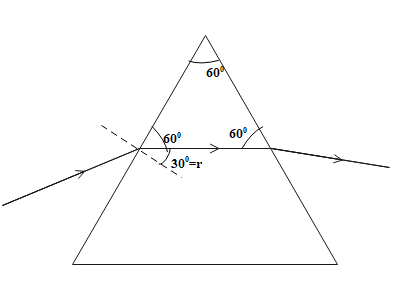
Two beams of red and violet colours are made to pass separately through a prism (angle of the prism is ${{60}^{\circ }}$). In the position of minimum deviation, the angle of refraction will be:
A.${{30}^{\circ }}$ for both the colours
B.Greater for the violet colour
C.Greater for the red colour
D.Equal but not ${{30}^{\circ }}$ for both the colours
Answer
454.2k+ views
Hint:In minimum deviation condition, the ray refracted from the air to the prism becomes parallel to the base of the prism. Also, the angle of refraction does not depend on the wavelength of light incident. Therefore, the angle of refraction will be calculated by applying basic geometry related to parallel lines and their intersections.
Complete answer:
The refractive index of prism, $\mu $ is also expressed as:
\[\mu =\dfrac{\sin \left[ \dfrac{A+{{\delta }_{m}}}{2} \right]}{\sin \left[ \dfrac{A}{2} \right]}\]
Where,
$A=$ angle of prism
${{\delta }_{m}}=$ angle of minimum deviation of prism
This formula proves that the angle of refraction and minimum deviation are independent of the wavelength of light.
Since, the refracted ray which was first incident on the surface of prism becomes parallel to the base of the prism, therefore, it also forms a small equilateral triangle like the prism with all three angles equal to ${{60}^{\circ }}$ as shown in figure.

The normal to the surface of the prism makes an angle of ${{90}^{\circ }}$ with the prism. Thus, we get
${{90}^{\circ }}={{60}^{\circ }}+r$
$\Rightarrow r={{30}^{\circ }}$
Therefore, the angle of refraction is ${{30}^{\circ }}$ and since it is independent of wavelength of light, hence the angle of refraction is ${{30}^{\circ }}$for both red and violet colour beams.
Therefore, the correct answer is (A) ${{30}^{\circ }}$ for both the colours.
Note:
For a given prism, the angle of deviation only depends on the angle of incidence. Studying from the angle of incidence equal to zero, as we increase the angle of incidence, the angle of deviation slowly decreases to a minimum value and then shoots up to infinity as we keep increasing the angle of incidence of the light ray. This can be observed easily with the graph of angle of incidence ($i$) v/s angle of deviation ($\delta $).
Complete answer:
The refractive index of prism, $\mu $ is also expressed as:
\[\mu =\dfrac{\sin \left[ \dfrac{A+{{\delta }_{m}}}{2} \right]}{\sin \left[ \dfrac{A}{2} \right]}\]
Where,
$A=$ angle of prism
${{\delta }_{m}}=$ angle of minimum deviation of prism
This formula proves that the angle of refraction and minimum deviation are independent of the wavelength of light.
Since, the refracted ray which was first incident on the surface of prism becomes parallel to the base of the prism, therefore, it also forms a small equilateral triangle like the prism with all three angles equal to ${{60}^{\circ }}$ as shown in figure.

The normal to the surface of the prism makes an angle of ${{90}^{\circ }}$ with the prism. Thus, we get
${{90}^{\circ }}={{60}^{\circ }}+r$
$\Rightarrow r={{30}^{\circ }}$
Therefore, the angle of refraction is ${{30}^{\circ }}$ and since it is independent of wavelength of light, hence the angle of refraction is ${{30}^{\circ }}$for both red and violet colour beams.
Therefore, the correct answer is (A) ${{30}^{\circ }}$ for both the colours.
Note:
For a given prism, the angle of deviation only depends on the angle of incidence. Studying from the angle of incidence equal to zero, as we increase the angle of incidence, the angle of deviation slowly decreases to a minimum value and then shoots up to infinity as we keep increasing the angle of incidence of the light ray. This can be observed easily with the graph of angle of incidence ($i$) v/s angle of deviation ($\delta $).
Recently Updated Pages
Master Class 12 Economics: Engaging Questions & Answers for Success

Master Class 12 Maths: Engaging Questions & Answers for Success

Master Class 12 Biology: Engaging Questions & Answers for Success

Master Class 12 Physics: Engaging Questions & Answers for Success

Master Class 12 Business Studies: Engaging Questions & Answers for Success

Master Class 12 English: Engaging Questions & Answers for Success

Trending doubts
The probability that a leap year will have only 52 class 12 maths CBSE

Describe the poetic devices used in the poem Aunt Jennifers class 12 english CBSE

And such too is the grandeur of the dooms We have imagined class 12 english CBSE

What does the god that failed refer to class 12 english CBSE

Which country did Danny Casey play for class 12 english CBSE

Draw a labelled sketch of the human eye class 12 physics CBSE




